| |
Low Incidence of Drug Resistance after Virologic Failure in HIV-1 Infected Subjects Randomized to Remain on their Current Protease Inhibitor (PI) or Switched to a Fosamprenavir Regimen for 24 Weeks (ELECT Study)
|
| |
| |
Reported by Jules Levin
3rd International Workshop on HIV Persistence during Therapy , 4-7 December 2007, St Maarten, West Indies
LL Ross1, B Young2 , E DeJesus3, A LaMarca4, P Salvato5, V Williams1, R Balu1, MS Shaefer1 for the ELECT Study
1GlaxoSmithKline, Research Triangle Park, NC, 2Denver ID Consultants, Denver, CO, 3Orlando Immunology Center, Orlando, FL, 4 Therafirst Medical Center, Ft Lauderdale, FL, 5Diversified Medical Practices, Houston, TX
AUTHOR CONCLUSIONS
Virologic suppression was maintained in subjects following the switch to FPV-containing antiviral therapy from their prior PI.
Low rates of VF (3%, 9/304) and drug resistance were observed for subjects who
switched to FPV-containing regimens and for subjects who remained on their current PI.
HIV-1 RNA resupression to <400 copies/mL after meeting VF criteria was observed for 2/4 subjects in the FPV-switch arm and 1/5 subjects who remained on their current PI regimen.
INTRODUCTION
Antiviral therapy (ART) tolerability is critical for adherence; increased adherence reduces the likelihood of drug resistance selection.
In this study, subjects with virologic suppression (HIV-1 RNA <400 copies/mL for at least 3 months prior to screening) who elected to switch ART due to tolerability issues were randomized to remain on their current protease inhibitor (PI) + 2 nucleoside or nucleotide reverse transcriptase inhibitors (N(t)RTIs) or to replace their current PI with a fosamprenavir (FPV) -containing regimen. The subjects must have been on their first PI-containing regimen consisting of a PI (±RTV) + 2 N(t)RTIs. There was no CD4+ cell count requirement.
The impact of therapy switch on virologic failure (VF) rates and drug resistance was examined. For subjects randomized to the FPV arm, investigators could choose between three dosing options: FPV 1400mg BID, FPV +ritonavir (/r) 700 mg/100mg BID or FPV/r 1400mg/200mg QD.
METHODS
Subjects were stratified at randomization based on their primary PI therapy -Atazanavir (ATV), Indinavir (IDV), Lopinavir (LPV), Nelfinavir (NFV), Ritonavir (/r), and Saquinavir (SQV). During the study, ART substitutions for randomized treatment were not allowed with the exception of a one-time addition or withdrawal of /r. Background therapy could not be changed during the study.
HIV from subjects with VF (defined as confirmed HIVRNA >400copies/mL at any time through week 24) underwent genotypic and phenotypic analysis (Monogram BioSciences, South San Francisco, CA). Confirmed failures could continue in the study as long as the HIV-1 RNA levels remain ≦2,000 copies/mL and at the discretion of the investigator in consultation with the sponsor. Subjects with confirmed HIV-1 RNA values >2000 copies/mL were to be discontinued from the study.
Genotypic analysis was not performed at baseline/switch, as a study entry criterion was HIV-1 RNA was <400 copies/mL at screen.
Drug resistance mutations were defined per 2006 IAS-USA guidelines. Subjects experiencing VF could remain in the study if their HIV-RNA was ≦2000 copies/mL.
RESULTS
Table 1. Baseline characteristics.
33% African-americans. 80% male. Median HIV-1 RNA 1.69 log c/ml. median CD4 415. 65% CDC class A at baseline, 18% class B, 24% class C.
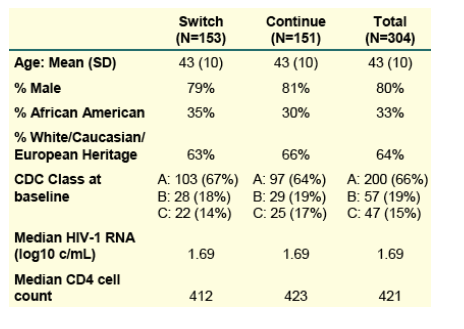
Table 2. Efficacy: Proportion <400 copies/mL
at Week 24 (ITT-Exposed).
TLOVR: 90% in Switch arm (n=153) & 93% in Continue arm (n=152) had <400 c/ml. By DM=F: 83% in Switch & 91% in Continue arms have <400 c/ml.
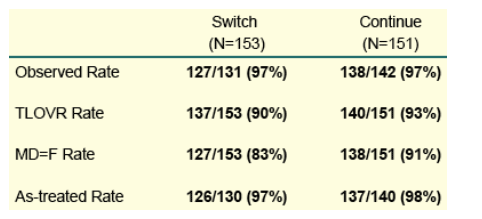
Table 3. Efficacy: Proportion <50 copies/mL at
Week 24 (ITT-Exposed).
TLOVR: 80% in Switch & 85% in Continue arms have <50 c/ml. MD=F: 78% in Switch & 86% in Continue arms have <50 c/ml.
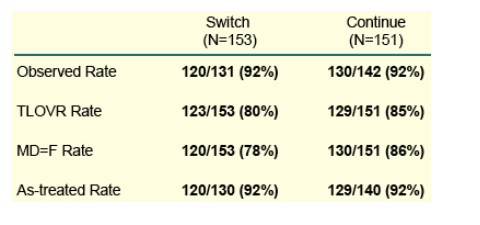
153/304 subjects in the ITT-exposed population were randomized to switch to fosamprenavir at baseline, 151/304 subjects remained on their current PI plus 2 N(t)RTIs. Baseline demographics for the two groups are shown in Table 1.
At 24 weeks, for the Observed analysis (Table 2): 127/131 (97%, n=153) of the subjects in the Switch arm and 138/142 (97%, n=151) of the subjects in the Continue arm had HIV-RNA <400 copies/mL; and at 24 weeks (Table 3) 120/131 of the subjects (92%, n=153) in the Switch arm and 130/142 (93%, n=151) in the Continue arm had HIV-RNA <50 copies/mL.
Nine subjects met VF criteria through 24 weeks- 4 subjects that switched to FPV (2 receiving FPV/r and 2 receiving FPV), and 5 subjects who remained on their current PI.
Figure 1: FPV/r arm: HIV from 2/4 subjects with VF had no reduced susceptibility to study drugs, and these two subjects subsequently re-suppressed to HIV-1 RNA <400 copies/mL by Week 24. Both subjects 1 and 2 experienced therapy interruptions prior to virologic failure determination. HIV at VF from the 3rd subject (who received unboosted FPV) had reduced susceptibility and drug resistance mutations to both the prior PI and FPV. Virus from 4th subject with VF, who also received unboosted FPV, had NRTI reduced susceptibility and also drug resistance mutations at VF. For 3/4 subjects, the sites reported that non-adherence or therapy interruption contributed to the determination of virologic failure.
Figure 2: Current PI arm: Subjects with VF included 2 subjects remaining on lopinavir/r, 1 subject on atazanavir, and 2 on nelfinavir. HIV from 3 subjects (2 lopinavir/r treated and 1 nelfinavir treated) had no reduced susceptibility or drug resistance mutations to study drugs at VF. HIV from the 4th subject (treated with nelfinavir) had M184V with NRTI reduced susceptibility at VF. Virus from the 5th subject (treated with atazanavir) had reduced susceptibility and drug resistance mutations to his current ART at VF. Only 1/5 of these subjects re-suppressed their HIV-1 RNA to <400 copies/mL by Week 24. For 4/5 subjects, the sites reported that non-adherence or therapy interruption contributed to the determination of virologic failure.
Figure 1. Longitudinal Population Genotypic and Phenotypic Changes for Subjects with Virologic Failure who Switched to FPV-based Regimens.
Subject 1: prior ART ABC/3TC+LPV/r, switch to ABC/3TC+FPV/r.PRO mutations: G16E, L63H/Q. FPV fold change=0.96 at week 16, LPV FC=0.92, r FC=0.86 at week 16. ABC FC=1.1, 3TC FC=1.19 at week 16; RC=172%.
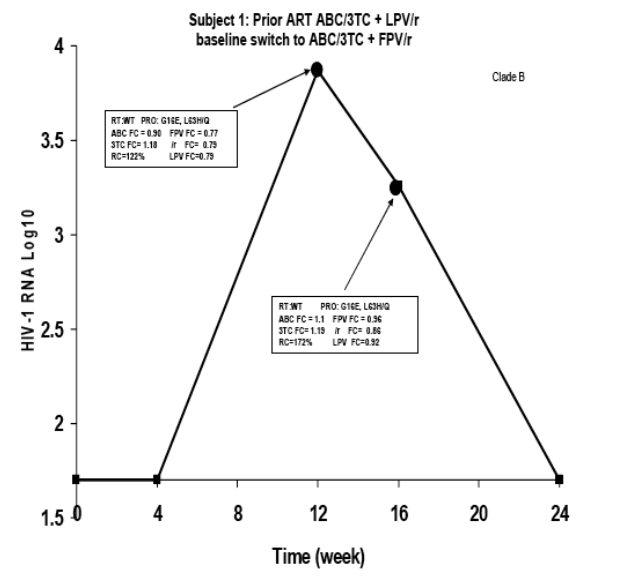
subject 2: prior ART TDF/FTC+LPV/r, switch to TDF/FTC+FPV/r. PRO mutations M36I, L63P at week 16. FPV FC=1.14, LPV FC=1.10, r FC=1.11. TDF FC=0.69, FTC FC=0.82, RC=89% at week 16. D4T FC=0.77, 3tc FC>MAX, RC=66% at week 24.
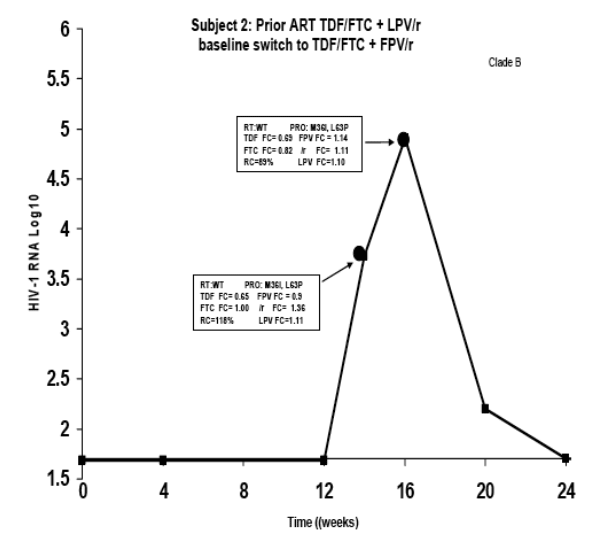
subject 3: prior ART d4T/3TC+ATV, switch to d4T/3TC+FPV. PRO mutations at week 24: M36!, I54I/L, L63(, A71T, V77V/I; ATV FC=2.12, FPV FC=1.19, r FC=1.76.
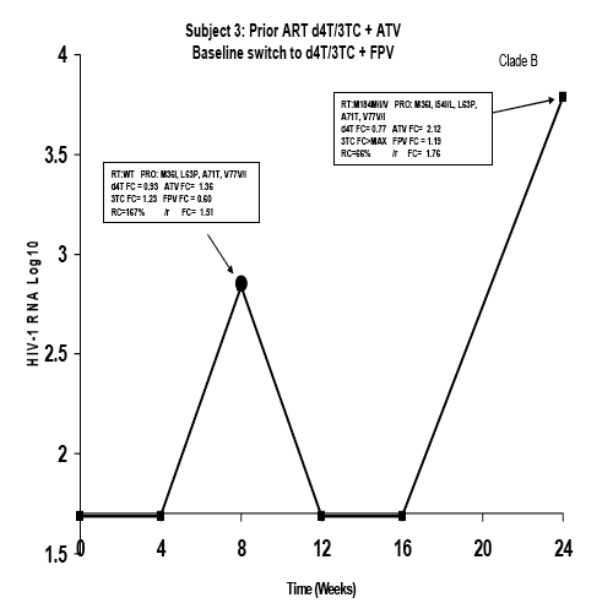
Subject 4: Prior ART d4T/TDF+IDV/r, switch to d4T/TDF+FPV. PRO mutations: at week 24: L10V, I13V, I50!/V, A71A/V, I84I/V. FPV FC=7.17, r FC=4.32, IDV FC=2.67.
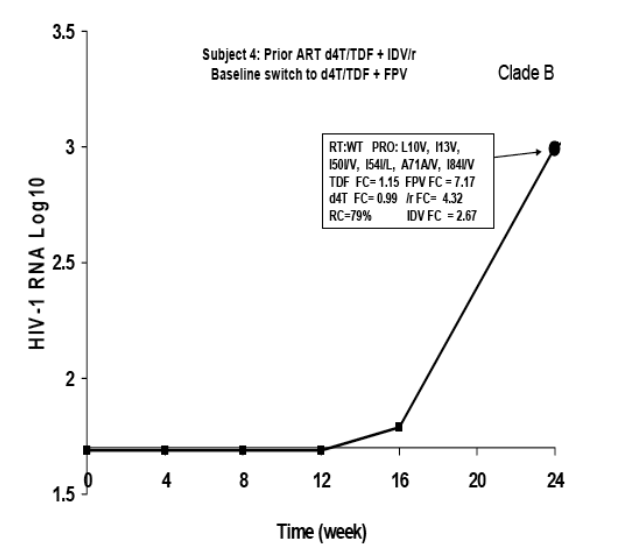
Figure 2. Longitudinal Population Genotypic and Phenotypic Changes for Subjects with Virologic Failure who Remained on their Original PI
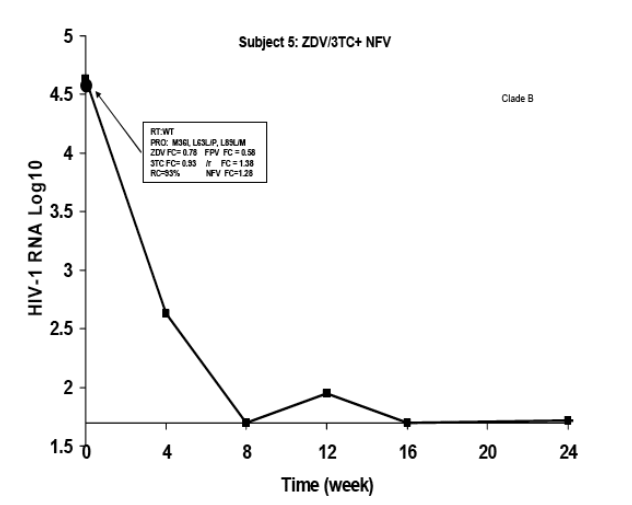
Subject 6: ABC/3TC+LPV/r. PRO mutation: L63P. K103N. FPV FC=0.4, RTV FC=0.42, LPV/r FC: 0.44, RC 7.8%, ABC FC=1.46, 3TC FC=1.05, EFV FC=20, NVP FC=29, DLV FC=27.
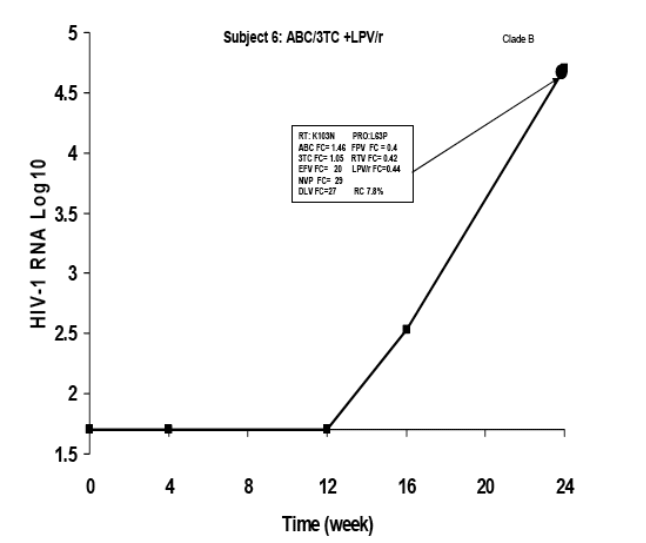
Subject 7: AZT/3TC+NFV: viral failure. Week 24 mutations, FC: RT: M184M/V; PRO: L63T, A71V, V77I. NFV FC=1.31, FPV FC=0.35, r FC=0.77, AZT FC=0.47, 3TC FC>MAX, FTC FC>MAX. ddI FC=1.35, RC=104%.
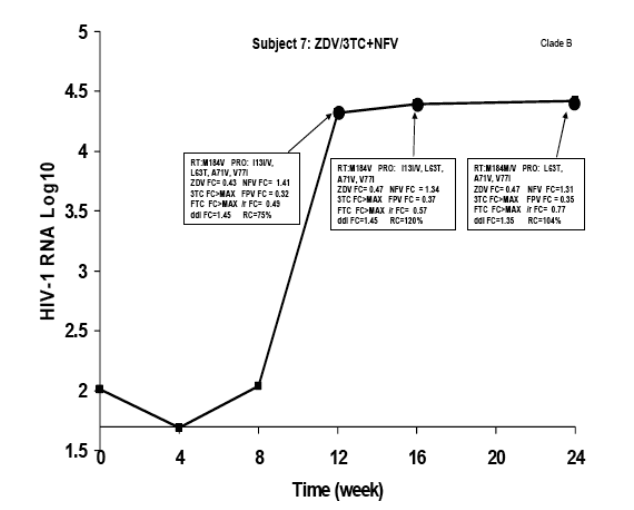
Subject 8: ABC/FTC+ATV.
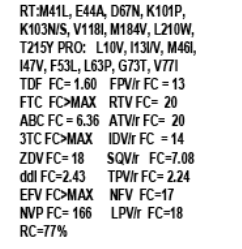
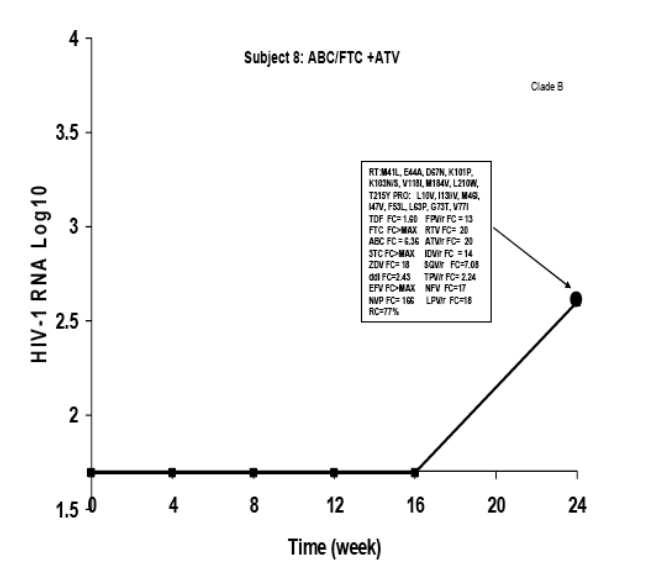
Subject 9: ABC/3TC+LPV/r.
PRO mutations: L63A, V77!, FPV FC=1.05, LPV/r FC=0.70, r FC=1.15. ABC FC=0.94, 3TC FC=1.18, RC=24%.
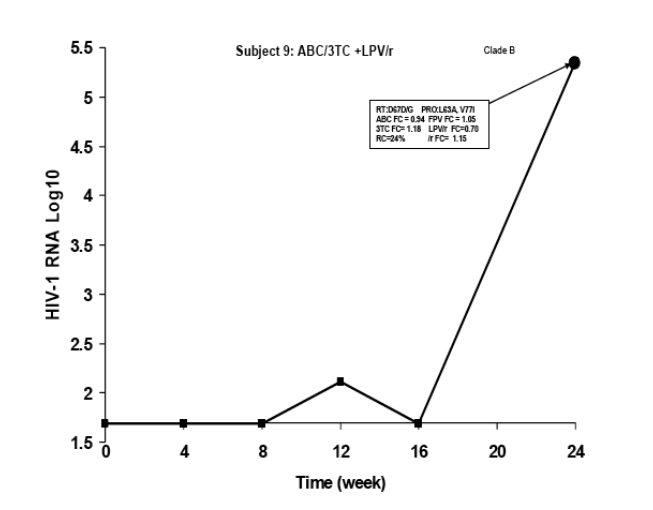
|
|
| |
| |
|
|
|